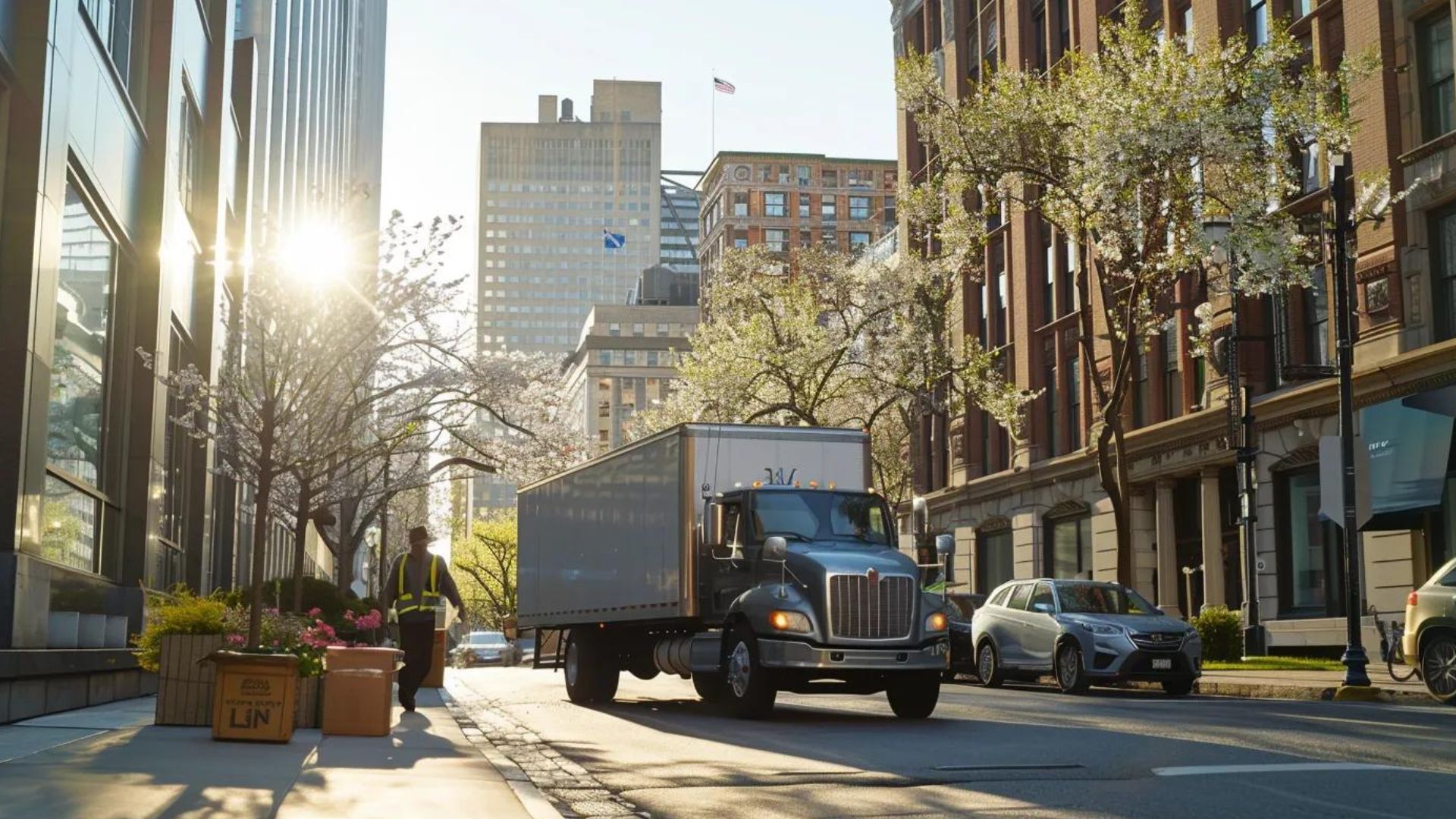Commercial Moving vs Residential: Logistics Management Differences
Commercial Moving vs Residential: Key Logistics Management Differences Explained

Commercial relocation logistics management demands tailored strategies compared to residential moves, balancing project scope, specialized equipment, timing constraints, and cost structures. Understanding these distinctions helps managers minimize downtime, protect sensitive assets, and control expenses. This guide maps out core differences in planning, equipment, scheduling, and cost factors before diving into specialized commercial practices, unique home-move challenges, equipment and asset management contrasts, and why professional movers like Anchor Point Moving deliver reliable solutions for both business and residential clients.
Moving Services Market Trends, Share and Forecast, 2025-2032
The global moving services market is estimated to be valued at USD 111.23 billion in 2025 and is expected to reach USD 159.67 billion by 2032, exhibiting a compound annual growth rate (CAGR) of 5.3% from 2025 to 2032.
This source provides an overview of the moving services market, including both residential and commercial aspects, which is relevant to the article's discussion of the differences between the two.
What Are the Main Differences Between Commercial and Residential Moving Logistics?
Commercial and residential moves differ in complexity, scale, and regulatory needs because offices require coordination among departments, IT systems, and employee schedules, while homes focus on personalized care for household items. A clear comparison highlights how project scope, planning depth, equipment, and cost drivers vary.
| Aspect | Commercial Moves | Residential Moves |
|---|---|---|
| Planning Timeline | 2–6 months with stakeholder approvals and phased execution | 2–6 weeks with homeowner coordination |
| Equipment | Server racks, pallet jacks, heavy-duty forklifts | Dollies, furniture pads, standard moving blankets |
| Scheduling Flexibility | After-hours/weekends to minimize business disruption | Weekdays or weekends, based on homeowner preference |
| Cost Structure | Volume-based estimates, insurance premiums, and regulatory fees | Hourly rates, packing materials, and optional service add-ons |
| Regulatory Needs | Compliance with data security, workplace safety standards | Local transit rules and basic liability insurance |
How Do Planning Requirements Differ for Commercial vs Residential Moves?
- Develop phased project plans aligned with business milestones and peak operational windows.
- Coordinate cross-functional teams—including IT, facilities, and human resources—to sequence asset transfers.
- Secure permits, parking zones, and data-handling approvals before move-out to avoid legal delays.
- Simplify household planning through homeowner walkthroughs, room-by-room inventories, and packing checklists.
- Schedule flexible pickup and delivery slots around personal commitments, schools, and community regulations.
What Specialized Equipment Is Used in Commercial Moves compared to Residential Moves?
| Machine | Application | Benefit |
|---|---|---|
| Server-safe carts | Transporting racks and hardware | Minimizes vibration and data loss risk |
| Pallet jacks | Moving pallets of supplies | Speeds up bulk transfers |
| Heavy-duty forklifts | Loading industrial machinery | Ensures operator safety under load |
| Standard dollies | Shifting sofas and appliances | Protects floors and walls |
| Furniture sliders | Sliding heavy pieces in tight spaces | Reduces carry strain |
How Does Timing and Scheduling Impact Commercial and Residential Moves?
- After-hours and weekend slots protect business continuity by avoiding interference with daily operations.
- Sequential department moves allow phased relocations, preventing complete shutdowns.
- Home moves leverage flexible vacancy windows in apartments or neighborhoods to suit personal calendars.
- Commercial deadlines often tie to lease expirations or fiscal quarters, requiring precise cut-offs.
- Residential moves accommodate school schedules, community noise ordinances, and utility activation dates.
What Are the Cost Factors Influencing Commercial vs Residential Moving?
- Labor costs increase when specialized crews are required for IT decommissioning or heavy machinery relocation.
- Insurance premiums rise with declared asset values and data-security provisions.
- Permit and regulatory fees apply to loading zones, oversized equipment, and hazardous material handling.
- Packing materials and add-on services—like furniture disassembly—contribute to residential move estimates.
- Seasonal demand fluctuations impact both sectors, with end-of-month leases or summer holidays raising rates.
Factors Influencing Commercial Relocation Costs
Commercial relocation costs are influenced by several factors, including the distance of the move, the size and complexity of the move, and the services required. Longer distances, larger inventories, and specialized equipment all contribute to higher costs.
This source provides a breakdown of the factors that influence commercial moving costs, which is relevant to understanding the cost planning and budgeting considerations discussed in the article.
How Is Commercial Moving Logistics Managed to Minimize Business Downtime?

Commercial relocation logistics management ensures uninterrupted operations by integrating precise planning, asset staging, and resource allocation.
What Are Best Practices for Planning Office Relocations?
- Conduct a full asset inventory, including furniture, IT hardware, and specialized machinery.
- Assign relocation champions in each department to coordinate on-site decisions.
- Create a backup plan for critical systems—such as temporary server hosting—to prevent data outages.
- Communicate timelines and responsibilities clearly through regular status meetings.
- Validate insurance coverage and perform pre-move risk assessments to avoid unexpected liabilities.
These practices inform secure transfer methods for technology assets.
How Is IT Infrastructure Safely Relocated During Commercial Moves?
- Label and photograph each component and cable configuration to ensure accurate reassembly.
- Pack servers in shock-absorbent crates with humidity-controlled liners.
- Transport network racks with power-down protocols and on-site reinstallation checklists.
- Coordinate with IT teams to schedule cut-over windows that minimize user impact.
- Validate system functionality immediately post-move through testing scripts and redundancy checks.
Next, managing employee relocation ensures workforce readiness.
How Does Employee Relocation Affect Commercial Moving Logistics?
- Provide clear move schedules and workspace maps so teams understand new office layouts.
- Offer relocation assistance programs, such as temporary workspace rentals or transit stipends.
- Host orientation sessions to familiarize staff with new facilities and emergency procedures.
- Assign move-day liaisons to address real-time concerns and equipment needs.
- Gather feedback after completion to refine future relocation protocols.
Employee Relocation Trends
Employee relocation is on the rise, with companies increasingly offering relocation packages to attract and retain skilled professionals. The use of nonstandard benefits and voluntary move policies is also increasing.
This research highlights the growing importance of employee relocation, which is a key aspect of commercial moving logistics, as discussed in the article.
Risk management completes the commercial planning cycle.
What Insurance and Regulatory Compliance Are Required for Commercial Moves?
- Secure cargo insurance with declared value coverage for expensive machinery and electronics.
- Ensure compliance with data privacy regulations when transporting sensitive documents or servers.
- Obtain building permits and loading-zone authorizations from local municipalities.
- Follow OSHA guidelines for workplace safety during pack-out and load-in operations.
- Maintain Certificates of Insurance (COI) to satisfy landlord or vendor requirements.
Having addressed commercial priorities, we turn to home moves’ unique demands.
What Are the Unique Logistics Challenges in Residential Moving?
Residential relocation logistics focuses on personalized scheduling, fragile-item protection, and homeowner convenience, requiring less regulatory oversight but more attention to sentimental assets.
Unique challenges include limited parking permits, tight stairwells in multi-unit buildings, and coordinating utility transfers, all while preserving personal valuables.
How Is Personalized Planning Tailored for Home Relocation?
- Conduct a detailed home walkthrough to identify fragile, oversized, or specialty items.
- Develop a personalized packing plan that groups items by room and priority.
- Schedule move-out and move-in dates based on lease terms, school calendars, and utility activation.
- Offer specialized packing services for antiques, artwork, or pianos as needed.
- Provide storage solutions for clients who require interim space between homes.
This tailored planning informs careful equipment choices for household items.
What Equipment and Packing Methods Are Used for Fragile Household Items?
- Use high-density foam, corrugated corner protectors, and custom wooden crates for glass and ceramics.
- Wrap furniture in quilted moving pads and secure with eco-friendly stretch wrap.
- Pack electronics in anti-static boxes with layered padding.
- Utilize wardrobe boxes to transport clothing without folding.
- Label all boxes with room and content details to streamline unpacking.
Robust packing sets up flexible scheduling that accommodates homeowner priorities.
How Does Scheduling Flexibility Differ in Residential Moves?
- Provide weekend or evening move slots when families are available to supervise.
- Offer same-day move options for short-notice changes in lease or purchase closings.
- Coordinate with utility providers to align service cut-offs and activations.
- Allow buffer days for client walkthroughs and final inspections.
- Adjust move schedules in real time to accommodate family emergencies or weather disruptions.
Scheduling influence also shapes cost estimates for home relocations.
What Factors Influence Residential Moving Costs?
- Number of movers and required travel time to and from the property.
- Volume and weight of household goods, including large furniture pieces.
- Complexity of packing services chosen—full, partial, or DIY packing options.
- Distance and transit fees for local versus long-distance moves.
- Seasonal demand surcharges, especially during summer months or end-of-month leases.
Having covered residential needs, we examine specialized equipment and asset management side by side.
How Do Specialized Equipment and Asset Management Differ Between Commercial and Residential Moves?
| Equipment Category | Commercial Asset | Residential Asset | Management Approach |
|---|---|---|---|
| Crating Systems | Server racks, industrial machines | Antiques, fine art | Barcode tracking; custom crate numbering |
| Material Handling | Forklifts, pallet jacks | Dollies, sliders | Scheduled staging zones; room-by-room staging |
| Packing Materials | Anti-static liners, surge protectors | Bubble wrap, packing paper | Asset tracking software; homeowner sign-off |
This contrast leads into details on the specialized gear essential for business moves.
What Types of Specialized Equipment Are Essential for Commercial Moves?
- Server carts with shock-absorbent mounts for IT hardware transfers.
- Industrial pallet jacks for stacked supplies and boxed inventory.
- Climate-controlled crates for pharmaceuticals or temperature-sensitive materials.
- Heavy-lift dollies and rigging straps for machinery extraction.
- Protective crates with built-in alarms for high-value equipment.
Those specialized methods contrast with residential handling of personal goods.
How Are Personal Belongings Handled Differently in Residential Moves?
- Use wardrobe and mirror boxes to prevent damage to clothing and glass surfaces.
- Implement color-coded labels matching each room plan to expedite unpacking.
- Provide padded lifts and hand carts for navigating stairs and tight hallways.
- Offer partial unpacking services for kitchenware and fragile collections.
- Utilize climate-controlled transport for temperature-sensitive artwork or wine cellars.
Effective asset management enhances commercial efficiency next.
How Does Asset Management Impact Commercial Moving Efficiency?
- Implement barcode scanning at packing, staging, and loading points for real-time inventory.
- Use digital dashboards to coordinate crew assignments and equipment staging.
- Schedule equipment decommissioning and re-installation based on asset priority.
- Automate notifications to stakeholders when critical assets arrive on-site.
- Analyze post-move data to refine future relocation timelines and reduce idle time.
Asset Management in the U.S. Market
The asset management market in the U.S. is anticipated to grow significantly, driven by technology integration, particularly the Internet of Things (IoT) devices and sensor technologies. IoT-enabled asset tracking systems provide real-time visibility into asset location, conditions, and performance, enabling proactive maintenance and minimizing downtime.
This source provides insights into asset management practices, which are crucial for commercial moving efficiency, as discussed in the article.
After exploring equipment and management, let’s discuss why a professional mover makes a difference.
Why Choose a Professional Moving Company for Both Commercial and Residential Moves?

Professional moving companies like Anchor Point Moving blend expertise, equipment, and project management capabilities to streamline relocations, protect assets, and ensure on-time delivery. Their trained crews and proprietary protocols reduce risk, simplify coordination, and create peace of mind for businesses and homeowners alike.
How Does Anchor Point Moving Tailor Solutions for Commercial Relocation Logistics?
- Assign dedicated move managers to oversee stakeholder communications and site surveys.
- Provide turnkey IT relocation services, including server packing, transit, and reinstallation.
- Coordinate phased move plans that align with lease expirations and fiscal cycles.
- Deploy certified crews trained in OSHA and data-security compliance.
- Offer post-move support for reconfiguration, asset audits, and efficiency improvements.
These same principles adapt to the residential space.
What Residential Moving Services Does Anchor Point Moving Offer for Homeowners?
- Full-service packing with specialty kits for artwork, antiques, and electronics.
- Climate-controlled vehicles and GPS tracking for secure transport.
- Unpacking, furniture setup, and debris removal for move-in convenience.
- Storage options in secure, monitored facilities when interim space is needed.
- Personalized move coordinators who tailor timelines to family schedules.
Both residential and commercial clients benefit from expert logistics management.
How Does Expert Logistics Management Ensure Secure and Timely Moves?
- Use digital move-management platforms to centralize timelines, inventories, and crew assignments.
- Conduct pre-move audits and post-move inspections to verify item condition.
- Provide transparent status reports to clients at every phase of relocation.
- Leverage strategic routing and vehicle utilization to optimize transit times.
- Maintain 24/7 support lines for on-demand assistance and issue resolution.
Having showcased professional value, we’ll address common questions without separate Q&A lists.
What Are the Common Questions About Commercial vs Residential Moving Logistics?
Clients often wonder about core distinctions, cost differences, and mover capabilities when comparing office and home relocations. Addressing these inquiries builds clarity and trust.
What Is the Difference Between Commercial and Residential Moving?
Commercial moving involves structured project management, specialized equipment, and compliance protocols to relocate offices, minimize downtime, and protect high-value assets. Residential moving focuses on personalized planning, standard moving tools, and flexible scheduling tailored to individual homes and families.
Is Commercial Moving More Expensive Than Residential?
Yes, commercial moves generally cost more due to extended planning timelines, custom equipment rentals, higher insurance premiums, and regulatory fees associated with business assets and data security. Residential moves typically feature lower hourly rates and standard coverage options.
Can Residential Movers Handle Commercial Relocations?
Residential movers handle basic household transfers but often lack the specialized equipment, project management expertise, and compliance knowledge required for large-scale office relocations, IT transitions, and multi-phase moves that commercial projects demand.
How Long Does a Commercial Move Take Compared to a Residential Move?
Commercial moves often span weeks or months of planning and are executed over several evenings or weekends to avoid operational disruptions. Residential moves are usually completed within one day or a weekend, following a shorter preparation period of a few weeks.
What Equipment Is Used Specifically for Commercial Moves?
Commercial moves rely on heavy-duty forklifts, pallet jacks, server carts, industrial crating systems, and climate-controlled containers to handle large volumes, protect sensitive electronics, and meet business-continuity requirements.
How Can Businesses and Homeowners Prepare for a Smooth Move?
Preparation steps differ by project scope but share a common foundation of inventory management, scheduling, and resource coordination to ensure an efficient relocation.
What Are the Key Steps in Commercial Relocation Planning?
- Conduct detailed asset and infrastructure audits to establish baselines.
- Assign departmental move leaders and define stakeholder roles.
- Develop phased transition timelines aligned with business milestones.
- Secure permits, IT backup plans, and insurance certificates.
- Stage equipment in temporary zones before final load-out.
- Schedule post-move validation tests for systems and workstations.
- Document lessons learned to refine future relocations.
These business-level steps parallel homeowner preparations.
How Can Homeowners Efficiently Plan Their Residential Move?
- Create a room-by-room inventory and purge unwanted items early.
- Book moving services at least four weeks in advance to secure preferred dates.
- Gather quality packing materials—boxes, padding, and labels—for each category of items.
- Prepare an essentials kit with important documents and valuables for easy access.
- Confirm utility cut-off and activation dates to align with move-in schedules.
- Label and color-code boxes by room to streamline unpacking.
Finally, tools and checklists bridge both move types.
What Tools and Checklists Help Compare Commercial and Residential Moves?
- Digital move-management platforms for inventory tracking and crew coordination.
- Printable checklists that outline pre-move, pack-out, and post-move tasks.
- Cost calculators to estimate labor, equipment, and permit fees side by side.
- Gantt chart templates for visualizing phased commercial relocation timelines.
- Room-mapping apps to preview furniture layouts in new office or home spaces.
Leveraging these resources fosters clarity, reduces stress, and sets the stage for a seamless transition—whether you’re moving an entire company or a single household.
When it’s time to relocate, aligning logistics with project scale and asset sensitivity ensures a secure and efficient move. By partnering with professionals who understand both commercial relocation logistics management and residential moving nuances, you protect your business continuity and preserve what matters most at home.










